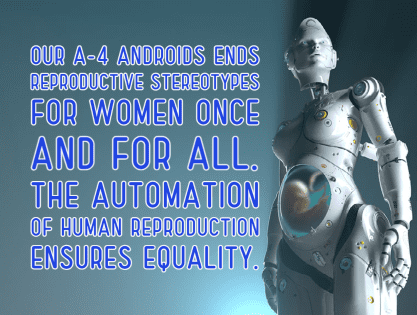She is also a clone of her father, and she has epigenetics effects that cause more masculine effects. For example, as a newborn, she was less responsive to auditory and social stimuli, which is considered a male trait. She exhibits “boyish” traits, including flexible clothing options and a tendency to eat rotten food on a dare. As sexual attraction goes, she’s indifferent. Sexual attraction isn’t about obtaining a mate in her time, but more about having simple sex.
Father’s Day Celebrations
But the oddest thing is Rosella doesn’t celebrate Father’s Day despite having a dad. Many people don’t in her time.
She celebrates Mother’s Day instead. Which is unusual for people in her period, as many don’t even bother with each holiday. This is because Rosella has always seen her father as her mother since realizing she was his clone as a teenager. As a young kid she called him “dad,” but once she discovered that she was his clone she started to call him “mǔqīn” which is Chinese for mother. Only later once he had died did she return to referring to him as “Dad”, but even so would not celebrate Father’s day, only Mother’s day.
The social death of these celebrations is not a simple matter, as there are many complex reasons behind it. For instance, socially they relate to society’s shift into space, the increasing female-to-male gender ratio on Earth, human cloning via advanced IV and CRISPR technologies, and the philosophical recognition of fatherhood and motherhood strictly as a social construct of rules and obligations.
This change had a large legal impact, as it removed any biological issues concerning child custody and support. During the turn of the Second Age of Humanity, many men in the U.S. were glad to see the legal changes, as now they were free from serving time for unpaid child support. Courts would implicate instead another man, who was with the woman at the time and posed as the father. Unmarried women were then required to prove that they were not acting as fathers to their children.
Quickly in society, the whole concept of motherhood and fatherhood was becoming obsolete. After all, human children were being seen as a manufactured product.
With the A-4 Android, the social roles of parenting became even more antiquated. People began viewing children as something to bring joy and pleasure, as well as social benefits, like higher UBI payments. Legally, though, A-4 Androids in the U.S. were never seen as mothers of the children they created despite being required to fulfill all the social roles.
As for gender…
Gender became a pure social construct in the 1970s because of social changes such as the repeal of anti-homosexuality laws and increased female workforce participation. A new scientific way to look at these issues was needed by sociology and using the term gender as a social construct fit the bill.
By Rosella’s time, the political issues surrounding gender were resolved. This happened in the late First Age of Humanity when issues about pronoun use fell apart as acceptance faded after people used indefinite pronouns to describe themselves such as “one” and “nobody.” This usage coincided with special political interests in the U.S. and Europe moving away from transgender issues into bariatric surgery and species alteration for children (the process of physically altering a child to look like certain animals such as a cat or dog).
Worse was that a considerable proportion of mid-life depression and identity crisis issues occurred in society because of children being mis-gendered earlier in life. This was because of lax medical standards during those times. Soon, the psychological and medical community realized that gender is truly a union of both biology and social constructs. Sociologists concurred with this opinion. Society changed how it approached “gender affirming care” creating greater medical guardrails, eliminating genetic intersex issues with cloning, and not harshly treating gender dysphoria like other untreatable psychological disorders of the time. However, even during Rosella’s time, less than 0.05% of people physically transitioned. Today an estimated “10% of cases” for children under 18 are using transitioning drugs. The reason for the difference is society’s sexual norms had changed allowing for greater freedom of sexual expression without bias, so many teens were able to resolve their gender dysphoria naturally without the need for transitioning.
Transitioning in Rosella’s time is known as complete anatomical gender reassignment (CAGR). This is where the human body undergoes a complete and total anatomical change from one sex to another without the use of hormones or drugs. It’s a complex surgical process involving the 3-D printing of new organs for transplant and grafting. The procedure results genetically in a person who is a genetic chimera. It has a high success rate but is irreversible because of the level of surgical interventions required and the stress the human body is placed under. All attempts to reverse this procedure have resulted in the patient’s death because of heart attack or organ failure caused by surgical stress. During Rosella’s time, the reversal was banned in many nations.
Click here to go to the Rosella Tolfree Website and read more posts.


